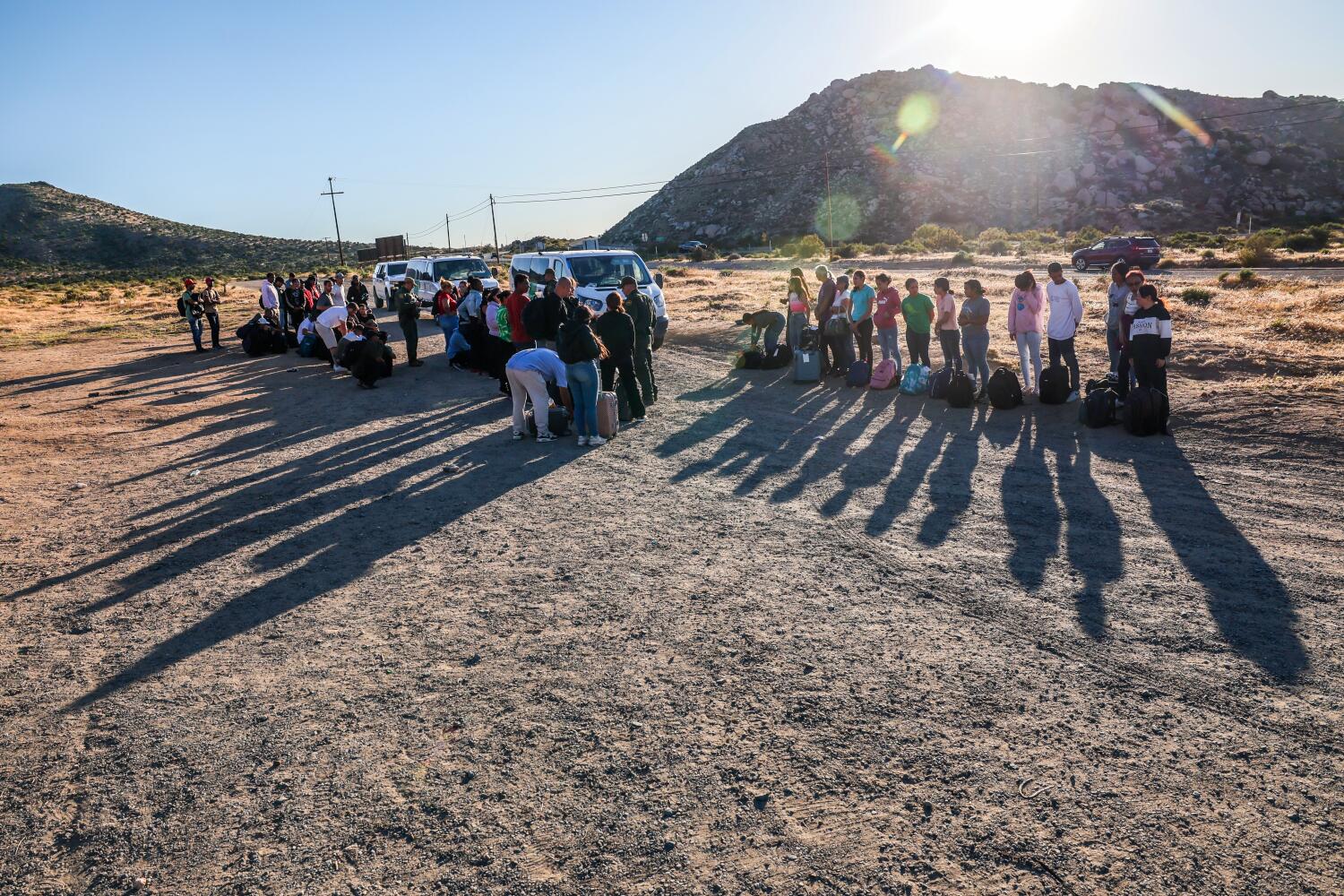-
Military Clash Between Thailand and Cambodia Expands Along Shared Border - 36 mins ago
-
Photos Show Bloody Frogs, Raw Sea Cucumbers Discovered in US Airport - 41 mins ago
-
How to Watch Dallas Wings vs Golden State Valkyries: Live Stream WNBA, Start Time, TV Channel - about 1 hour ago
-
The Line Trump Crossed by Accusing Obama of Treason - about 1 hour ago
-
Red Sox World Series Champion Drops Blockbuster Trade Prediction For 11-Time All-Star - 2 hours ago
-
Under Siege From Trump and Musk, a Top Liberal Group Falls Into Crisis - 2 hours ago
-
India’s New Deals Leave US to Catch Up - 2 hours ago
-
Trump Administration to Release $5.5 Billion in Frozen Schools Funding - 3 hours ago
-
How to Watch Australia vs British & Irish Lions: Live Stream Rugby, TV Channel - 3 hours ago
-
Why Zelensky Backtracked on His Controversial Law - 4 hours ago
Seeking the illusive path for immigrants to legally come to U.S.: ‘People are dying in line’

John Manley is sick of people telling immigrants to “stand in line” and “do it the right way.”
An immigration attorney for almost three decades in Los Angeles, he said what most don’t understand is that trying to legally come into the United States is nearly impossible for people from certain nations like Mexico.
“People are dying in line,” he said. In some cases, “it’s literally a 150 year wait.”
Manley said one of his clients, a U.S. citizen originally from Mexico who petitioned his two brothers to become legal residents, waited more than 15 years and wound up burying them instead of giving them the good news.
“They’re trying their best. They’re waiting in line,” he said. “But when you have a system that was essentially designed to fail from the beginning it’s difficult to have faith in that system.”
Immigration laws have not seen a wholesale reform in nearly 40 years, but as the Trump Administration cracks down on undocumented migrants, politicians are seeing a window of opportunity. Economists, immigration attorneys and scholars say that without another relief valve, it is not just the immigrants who will suffer but people in a wide swath of the economy.
Sen. Alex Padilla (D-California) on Monday plans to introduce legislation that could potentially provide a path to citizenship to 11 million immigrants who have lived in the U.S. for at least seven years. With a Republican led House and Senate, the legislation, which died last year, is unlikely to pass, but Padilla said he wanted to re-introduce the bill because he sensed a “mood shift” in Congress and across the country.
He’s not the only one. Earlier this month in the House, Reps. Maria Elvira Salazar, (R-Fla.), and Veronica Escobar, (D-Texas) dusted off their legislation, the Dignity Act, which would give qualified undocumented immigrants living here prior 2021 up to seven years of legal status with work authorization.
For decades, both Republicans and Democrats have tried and failed to bring reforms to what is widely viewed as an outdated system, which in the last fiscal year approved 3% of the 34.7 million pending green card applications, according to David Bier, a researcher at the Cato Institute.
“Given the extreme overreach of the Trump administration, I believe now’s the time,” Padilla said. “You talk to colleagues on both sides of the aisle about farm workers, agricultural workers. They say that farm workers deserve better, but the political will hasn’t been there for many, many years.”
But the imagery of Trump’s enforcement actions against non-criminals — videos of mothers wailing as they’re separated from children and arrests of workers and vendors outside of Home Depots — have seeped into the national consciousness and drawn criticism across political lines.
A Gallup poll released earlier this month showed record-high support for immigration. When asked if immigration is generally a good thing or bad thing for the country, 79% of U.S. adults called it a good thing. And a record-low 17% viewed it as a bad thing.
Just a year earlier, Americans concerned about their own pocketbooks were increasingly anxious about the waves of immigrants at the Southern border and voted in President Trump, whose hardline policies on immigration was at the center of his campaign.
In 2024, Gallup poll showed that 64% viewed it as a good thing and 32% as a baad thing.
When asked about the Dignity Act earlier this month, White House spokeswoman Karoline Leavitt said the president had not read through the legislation but he “has made it very clear, he will not support amnesty for illegal aliens in any way.”
Under both Democratic and Republican administrations, America has looked the other way as immigrants have filled jobs picking in the fields, cooking and cleaning in the back of restaurants, taking care of children and building homes.
But with the Trump Administration’s stepped up enforcement, net migration will likely turn negative in 2025, and monthly job growth and the GDP could fall by the end of this year, according to a paper from the conservative American Enterprise Institute.
One of the paper’s authors, Brookings Institution economist Tara Watson, said this drop in migration hasn’t happened since they have been keeping records in 1960. A typical year would bring in about 1.2 million people, about 600,000 of whom come legally on green cards from abroad and others who cross illegally or come seeking asylum or another status.
The paper projects the U.S. could lose as much as 525,000 people and could reduce domestic product growth, or GDP by 0.3 to 0.4%.
She called a projection in negative migration “shocking.”
“All of the growth in our labor force comes from immigration,” she said. “Our workforce that was born in the U.S. is actually now at the stage where it’s shrinking.”
If this trend continues to drag on, she said, it could make the United States less appealing to academics, scientists, tech workers and PhD students.
“We have built a whole infrastructure around global talent,” she said. “If we lose that this could be a long run, really, really damaging effect on our economy. In the short run, I would say it’s going to slow our growth.”
Immigration-enforcement hardliners like Ira Melhman, with the Federation for American Immigration Reform, counters that an economy that is built on the cheap labor of immigrants degrades conditions for American workers.
“You can create self-fulfilling prophecies, that if you offer poor wages and poor working conditions, and Americans don’t show up and apply for those jobs, and then you turn around and say, ‘Well, you see, only immigrants will take them,’” he said.
His group advocates for “merit based migration” and says “chain migration” or family-based migration needs to be eliminated except when it comes to immediate relatives.
Under the Immigration and Nationality Act of 1965, the U.S. made admitting immigrants with relatives here a priority. The system replaced racially tinged national-origins quotas, that dated back to the 1920, and favored European immigrants.
Every year about 1 million people get a green card — a prelude to citizenship — through four basic ways: a family relationship, work, a lottery system or as a refugee or asylee. The most common way is through family ties, and many of those approved are already living in the U.S.
The current system imposes caps on the number of green cards approved for family – excluding immediate relatives — to 226,000 a year. And it also caps employment based green cards to 140,000 annually, although there are exceptions.
Family relationships, like the one Manley’s clients were using, are lifetime waits and many can take decades. If you applied for a Mexican sibling 24 years ago, your case would just be coming up. But those wait times are now longer, as the docket has grown. For India, cases 19 years old are now being approved, and for nearly all other countries it has been taking about 17 years.
The declining birthrates and aging demographics means that the labor force can’t keep up with demand. Bier has pointed out that the United States ranks in the bottom third of wealthy countries for immigrants per capita.
The result is a pent up demand that lures workers to come illegally.
“There is a mismatch between the economy and the legal system that has created, for many years, a system where … the invitation to the workers is built in, but there’s no lawful status offered,” said Hiroshi Motomura, co-director of UCLA ‘s Center for Immigration Law and Policy. “And then what happens is their lives, the workers lives, become very precarious.”
Carl Shusterman, an immigration lawyer who has been practicing since the 1970s says he sees it everyday near his home on the Westside and in his practice.
“Go into any restaurant and look at who’s cooking the food, or you see who’s building the buildings in the fancy, fancy neighborhoods, or who’s mowing the lawns or taking care of the kids, or just pick almost any industries, and you’ll see that either there’s no way for these people to get legalized status.”
Source link





















